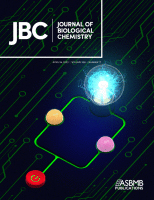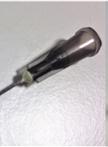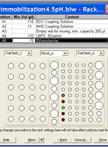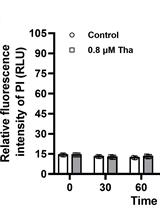- EN - English
- CN - 中文
A Fluorescence Dequenching-based Liposome Leakage Assay to Measure Membrane Permeabilization by Pore-forming Proteins
一种以测定成孔蛋白膜通透性的基于荧光淬灭的脂质体渗漏测定方法
发布: 2021年05月20日第11卷第10期 DOI: 10.21769/BioProtoc.4025 浏览次数: 6990
评审: Guangzhi ZhangHimanshu SharmaShailesh Kumar
Abstract
Pore-forming toxins (PFTs) have been discovered in a wide range of organisms. Their functions are essential to the survival or virulence of many species. PFTs often interact with lipid membranes. Large unilamellar vesicles (LUV), also known as liposomes, have been commonly used as reliable membrane models for testing PFTs activity. Liposomes have great adaptability in size, lipid composition, and loading cargo. Incorporating the fluorescent dye/quencher pair, 8-Aminonaphthalene-1,3,6-Trisulfonic Acid (ANTS) and p-Xylene-Bis-Pyridinium Bromide (DPX), in liposomes is an effective approach for measuring membrane leakage. When ANTS and DPX are encapsulated in a liposome, the fluorescence of ANTS is quenched by DPX. However, disruption of liposome integrity and subsequent leakage result in measurable fluorescence emitted by ANTS. Here, we report our protocol for optimal liposome preparation for measuring liposome leakage by fluorescence dequenching.
Keywords: Fluorescence dequenching (荧光淬灭)Background
Pore-forming toxins (PFTs) are a family of virulence factors produced by microbial pathogens for host invasion (Alouf et al., 2005). The major action of PFTs is forming pores on lipid membranes, resulting in membrane lysis and/or translocation of other effector proteins into host cells (Bischofberger et al., 2009). Liposomes have long been used as a biological membrane model for protein-membrane interactions due to their great adaptability in size, lipid composition, and loading cargo (Chatterjee and Agarwal, 1988). A common way of using liposomes to measure pore formation or membrane leakage is to encapsulate ions or fluorescent dyes inside liposomes. Upon liposome rupture, the released ions or fluorescent dyes emit measurable signals. We first used a K+ release assay to measure pore formation on liposomal membranes by the anthrax toxin (Sun et al., 2007 and 2008; Sun and Collier, 2010). Later, the fluorescence dye and quencher pair ANTS/DPX caught our attention (Nieva et al., 1989; Ruiz-Argüello et al., 1996). Compared with the K+ release assay, which requires a bulky K+ probe and frequent changes of costly probe membranes, the ANTS/DPX dequenching assay featured higher sensitivity, more accurate and consistent measurements, and lower cost. Therefore, over the past ten years, we have transitioned to the ANTS/DPX dequenching assay. With this assay, we have successfully measured the membrane permeabilizing activity (MPA) of Mycobacterium tuberculosis (Mtb) virulence factors. The two effector proteins, 6-kDa early secreted antigenic target (ESAT-6) or EsxA and 10-kDa culture filtrate protein (CFP-10) or EsxB have been tested with various experimental designs and settings (De Leon et al., 2012; Ma et al., 2015; Peng et al., 2016; Zhang et al., 2016; Aguilera et al., 2020; Ray et al., 2019). EsxAB is a heterodimer implicated in penetrating the phagosomal membrane of macrophages, allowing for translocation of Mtb into the cytosol (De Leon et al., 2012; Ma et al., 2015; Zhang et al., 2016; Aguilera et al., 2020). Recently, we have identified a new lipid composition for liposomes that greatly enhances the MPA of EsxA (Ray et al., 2019; Vazquez-Reyes et al., 2020). Here, we describe in detail the fluorescence dequenching based liposome leakage assay with our new lipid composition.
Materials and Reagents
Screw cap glass vials with PTFE screwcap (Spectrum Chemical, catalog number: 985-92215)
Cuvette spinbar (VWR, catalog number: 58949-030)
Quartz UV cuvette (Fireflysci, catalog number: 1FLUV10)
515 nm filter (Andover Corporation, catalog number: 515FG05-50S)
1 ml syringe (BD, catalog number: 309659)
9’’ Pasteur pipet (Fisher scientific, catalog number 13-678-6b)
Saint-Gobain Tygon tubing (Saint-Gobain, catalog number: ACF00017F)
Glass tube rack (Fisher Scientific, catalog number: K7492100100)
HiTrap® desalting columns (Millipore-Sigma, catalog number: GE17-1408-01)
Gel loading pipet tips (Fisherbrand, catalog number: 02-707-139)
10 mm filter supports (Avanti Polar Lipids, catalog number: 610014)
0.2 µm membrane (Whatman, catalog number: 800281)
Aluminum foil (Fisherbrand, catalog number: 01-213-100)
1 ml sample loop (Thermo Scientific, catalog number: 03-052-382)
Chloroform (Fisher Chemical, catalog number: c298)
1,2-Dioleoyl-sn-glycero-3-phosphocholine (DOPC) (Avanti Polar Lipids, catalog number: 850375)
1,2-dioleoyl-sn-glycero-3-[(N-(5-amino-1-carboxypentyl) iminodiacetic acid) succinyl] (nickel salt) (18:1 DGS-NTA(Ni) (Avanti Polar Lipids, catalog number: 790404)
1-palmitoyl-2-oleoyl-sn-glycero-3-phospho-(1'-rac-glycerol) (sodium salt) (POPG) (Avanti Polar Lipids, catalog number: 840457)
1-palmitoyl-2-oleoyl-glycero-3-phosphocholine (POPC) (Avanti Polar Lipids, catalog number: 850457)
Ethanol (Fisher Chemical, catalog number: a4094)
HPLC grade water (Fisher Chemical, catalog number: W5-4)
Tris-base (Fisher Chemical, catalog number: BP152)
Sodium chloride (Fisher Chemical, catalog number: BP358)
Sodium hydroxide (Fisher Chemical, catalog number: S318)
Hydrochloric acid (Fluka, catalog number: 7647)
Dry ice
4-(2-Hydroxyethyl)piperazine-1-ethanesulfonic acid, N-(2-Hydroxyethyl)piperazine-N′-(2-ethanesulfonic acid) (HEPES) (Fisher Bioreagents, catalog number: BP310)
8-Aminonaphthalene-1,3,6-trisulfonic acid, disodium salt (Setareh Biotech, catalog number: 6951)
p-Xylene-bis-pyridinium bromide (DPX) (Setareh Biotech, catalog number: 6271)
Triton X-100 (Sigma-Aldrich, catalog number: X100)
Sodium acetate (Sigma-Aldrich, catalog number: S2889)
Methanol (Fisher, catalog number: A453-500)
Gel filtration buffer (see Recipes)
pH 4 buffer (see Recipes)
Equipment
Glass tubes (VWR, catalog number: 89000-502)
50 ml beaker (Pyrex, catalog number: 02-540G)
Lab mounting stand (Humboldt MFG Company, catalog number: H-21217)
Nitrogen gas tank
Gas tank regulator (VWR, catalog number: 55850-277)
Large top desiccator (Corning Life Sciences, catalog number: CLS3120250)
Hot plate/stirrer (Thermo Fisher Scientific, catalog number: SP131325)
Extruder set with heating block (Avanti Polar Lipids, catalog number: 610000)
pH meter (Mettler Toledo, catalog number: 30266626)
Vortex (VWR, catalog number: 58816-121)
Scale (Mettler Toledo, catalog number: ML54)
AKTA FPLC system (General Electric, catalog number: UPC-900 and P920)
Fluorometer (ISS, catalog number: K2)
Water bath (VWR, catalog number: 13271-086)
Procedure
文章信息
版权信息
© 2021 The Authors; exclusive licensee Bio-protocol LLC.
如何引用
Readers should cite both the Bio-protocol article and the original research article where this protocol was used:
- Aguilera, J., Vazquez-Reyes, S. and Sun, J. (2021). A Fluorescence Dequenching-based Liposome Leakage Assay to Measure Membrane Permeabilization by Pore-forming Proteins. Bio-protocol 11(10): e4025. DOI: 10.21769/BioProtoc.4025.
- Aguilera, J., Karki, C. B., Li, L., Vazquez Reyes, S., Estevao, I., Grajeda, B. I., Zhang, Q., Arico, C. D., Ouellet, H. and Sun, J. (2020). Nα-Acetylation of the virulence factor EsxA is required for mycobacterial cytosolic translocation and virulence. J Biol Chem 295(17): 5785-5794.
分类
生物化学 > 蛋白质 > 相互作用 > 蛋白质-脂质相互作用
微生物学 > 微生物蛋白质组学 > 膜蛋白
您对这篇实验方法有问题吗?
在此处发布您的问题,我们将邀请本文作者来回答。同时,我们会将您的问题发布到Bio-protocol Exchange,以便寻求社区成员的帮助。
Share
Bluesky
X
Copy link













